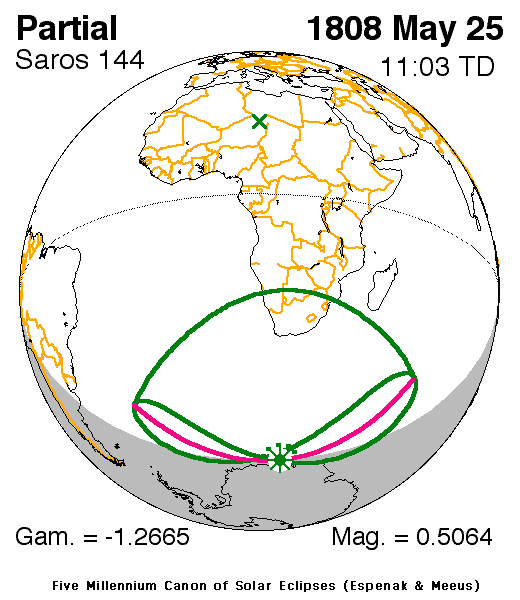A partial eclipse of the Sun occurred on Wednesday 25 May, 1808 UT (13 May, 1808 Old Style), with maximum eclipse at 11:02 UT. A moderate partial eclipse, with 51% of the Sun covered for viewers closest to the center, created an interesting spectacle.
Maximum eclipse was at 11:02:23 UT.
During this eclipse the Sun was 0.526° in apparent
diameter, 1.3% smaller than average. The Moon was just 3 days past apogee, making it very small.
At maximum eclipse it was 0.496° in apparent
diameter, which is 6.6% smaller than average. This has no real
effect on this eclipse, since the Moon's central
shadow misses the Earth, making this a partial eclipse.
The statistics page has information on the ranges of the sizes of
the Sun and Moon, and the Moon data page displays detailed
information on the Moon's key dates.
Overview Map
This map sourced from NASA Goddard Space flight Center: GSFC Eclipse Web SiteGSFC Eclipse Web Site
The primary source of all the information on eclipses presented here at Hermit Eclipse. (NASA Goddard Space flight Center)
shows the visibility of the partial solar eclipse. (Click on it for the
full-sized version.)
Eclipse Season and Saros Series
This eclipse season contains 2 eclipses:
This was the 5th eclipse in solar Saros series 144.The surrounding eclipses in this Saros series are:
This Saros series, solar Saros series 144,
is linked to lunar Saros series 137. The
nearest partner eclipses in that series are:
Eclipse Parameters
| UT Date/time (max) | 11:02:23 on 25 May UT |
TDT Date/time (max) | 11:02:35 on 25 May TDT |
| Saros Series | 144 |
Number in Series | 5 |
| Penumbral Magnitiude | |
Central Magnitiude | 0.5064 |
| Gamma | -1.2665 |
Path Width (km) | 0 |
| Delta T | 0m12s |
Error | ± 0m01s (95%) |
| Penumbral Duration | |
Partial Duration | |
| Total Duration | |
| |
| Partial Rating | |
Total Rating | |
| Sun Distance | 151631964 km (93.8%) |
Moon Distance | 401351 km (89.4%) |
| Sun Diameter | 0.526° |
Moon Diameter | 0.496° - 0.496° |
| Apogee | 00:01 on 22 May UT |
Perigee | 16:24 on 6 Jun UT |
Note that while all dates and times on this site (except
where noted) are in UT, which is within a second of civil time,
the dates and times shown in NASA's eclipse listingsGSFC Eclipse Web Site
The primary source of all the information on eclipses presented here at Hermit Eclipse. (NASA Goddard Space flight Center)
are in the TDT timescale.
The Sun and Moon distances are shown in km, and as a
percentage of their minimum - maximum distances; hence 0%
is the closest possible (Earth's perihelion, or the
Moon's closest possible perigee) and 100% is
the farthest (aphelion, the farthest apogee).
The statistics page has information on the ranges of sizes
of the Sun and Moon, and the Moon data page displays detailed
information on the Moon's key dates.
Data last updated: 2015-06-21 22:11:46 UTC.

